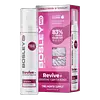What's inside
What's inside
 Key Ingredients
Key Ingredients

No key ingredients
 Benefits
Benefits

 Concerns
Concerns

 Ingredients Side-by-side
Ingredients Side-by-side

Water
Skin ConditioningIsobutane
Trimethoxycaprylylsilane
SmoothingOleth-100
Cetyl Alcohol
EmollientCetearyl Alcohol
EmollientTerminalia Chebula Extract
AstringentBiotin
AntiseborrhoeicAsparagus Racemosus Root Powder
Skin ConditioningSodium Hyaluronate
HumectantFolic Acid
Skin ConditioningSorbitan Fatty Acid Ester
EmulsifyingDecyl Glucoside
CleansingPvm/Ma Decadiene Crosspolymer
Myristyl Alcohol
EmollientStearyl Alcohol
EmollientEthylhexylglycerin
Skin ConditioningGlycerin
HumectantSodium Hydroxide
BufferingLeuconostoc/Radish Root Ferment Filtrate
AntimicrobialPhenoxyethanol
PreservativeWater, Isobutane, Trimethoxycaprylylsilane, Oleth-100, Cetyl Alcohol, Cetearyl Alcohol, Terminalia Chebula Extract, Biotin, Asparagus Racemosus Root Powder, Sodium Hyaluronate, Folic Acid, Sorbitan Fatty Acid Ester, Decyl Glucoside, Pvm/Ma Decadiene Crosspolymer, Myristyl Alcohol, Stearyl Alcohol, Ethylhexylglycerin, Glycerin, Sodium Hydroxide, Leuconostoc/Radish Root Ferment Filtrate, Phenoxyethanol
Alternatives
Ingredients Explained
These ingredients are found in both products.
Ingredients higher up in an ingredient list are typically present in a larger amount.
Cetyl Alcohol is a fatty alcohol. Fatty Alcohols are most often used as an emollient or to thicken a product.
Its main roles are:
Though it has "alcohol" in the name, it is not related to denatured alcohol or ethyl alcohol.
The FDA allows products labeled "alcohol-free" to have fatty alcohols.
Learn more about Cetyl AlcoholGlycerin is already naturally found in your skin. It helps moisturize and protect your skin.
A study from 2016 found glycerin to be more effective as a humectant than AHAs and hyaluronic acid.
As a humectant, it helps the skin stay hydrated by pulling moisture to your skin. The low molecular weight of glycerin allows it to pull moisture into the deeper layers of your skin.
Hydrated skin improves your skin barrier; Your skin barrier helps protect against irritants and bacteria.
Glycerin has also been found to have antimicrobial and antiviral properties. Due to these properties, glycerin is often used in wound and burn treatments.
In cosmetics, glycerin is usually derived from plants such as soybean or palm. However, it can also be sourced from animals, such as tallow or animal fat.
This ingredient is organic, colorless, odorless, and non-toxic.
Glycerin is the name for this ingredient in American English. British English uses Glycerol/Glycerine.
Learn more about GlycerinWater. It's the most common cosmetic ingredient of all. You'll usually see it at the top of ingredient lists, meaning that it makes up the largest part of the product.
So why is it so popular? Water most often acts as a solvent - this means that it helps dissolve other ingredients into the formulation.
You'll also recognize water as that liquid we all need to stay alive. If you see this, drink a glass of water. Stay hydrated!
Learn more about Water